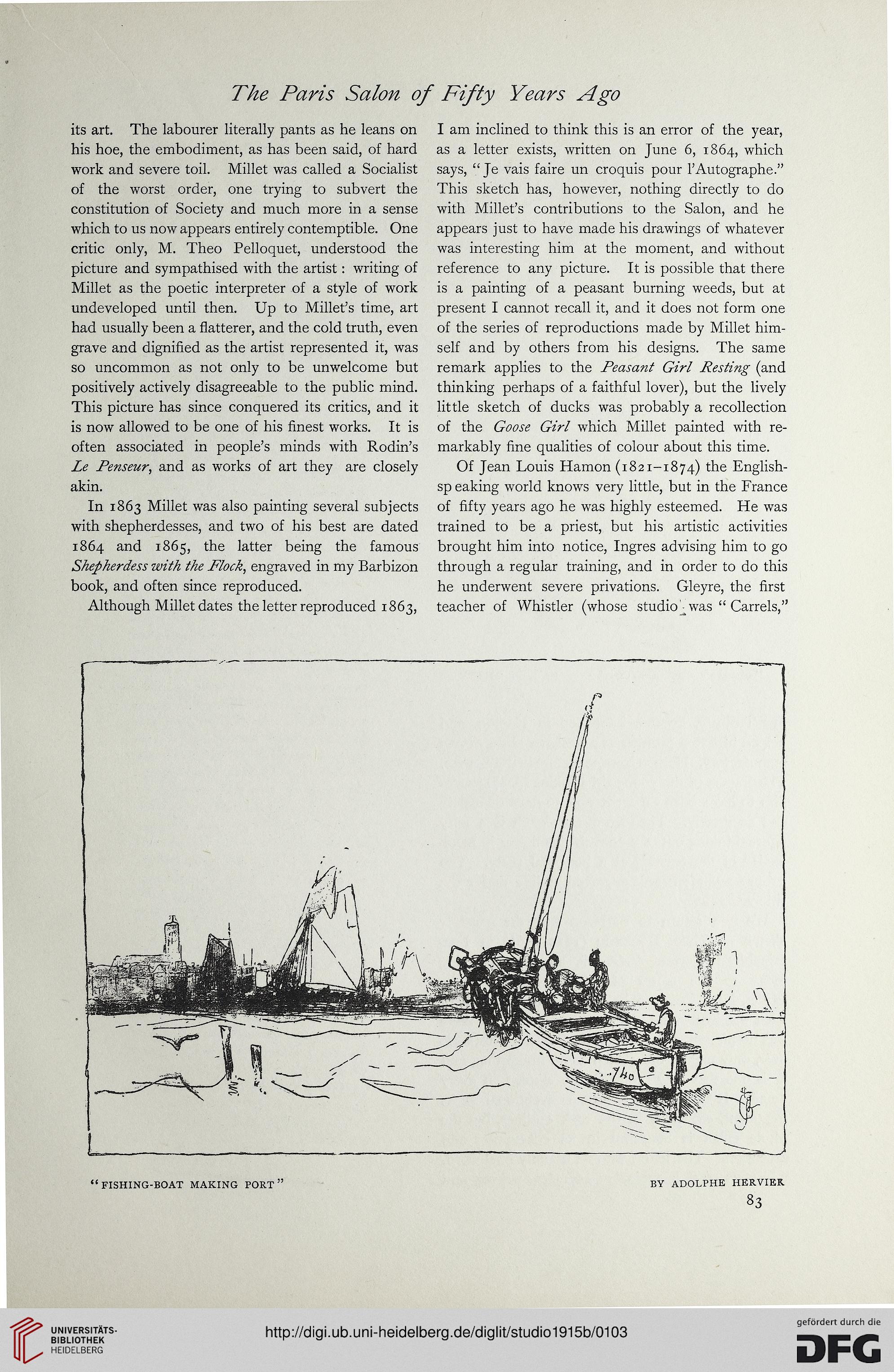The Paris Salon of Fifty Years Ago
its art. The labourer literally pants as he leans on
his hoe, the embodiment, as has been said, of hard
work and severe toil. Millet was called a Socialist
of the worst order, one trying to subvert the
constitution of Society and much more in a sense
which to us now appears entirely contemptible. One
critic only, M. Theo Pelloquet, understood the
picture and sympathised with the artist: writing of
Millet as the poetic interpreter of a style of work
undeveloped until then. Up to Millet’s time, art
had usually been a flatterer, and the cold truth, even
grave and dignified as the artist represented it, was
so uncommon as not only to be unwelcome but
positively actively disagreeable to the public mind.
This picture has since conquered its critics, and it
is now allowed to be one of his finest works. It is
often associated in people’s minds with Rodin’s
Le Penseur, and as works of art they are closely
akin.
In 1863 Millet was also painting several subjects
with shepherdesses, and two of his best are dated
1864 and 1865, the latter being the famous
Shepherdess with the Flock, engraved in my Barbizon
book, and often since reproduced.
Although Millet dates the letter reproduced 1863,
I am inclined to think this is an error of the year,
as a letter exists, written on June 6, 1864, which
says, “ Je vais faire un croquis pour l’Autographe.”
This sketch has, however, nothing directly to do
with Millet’s contributions to the Salon, and he
appears just to have made his drawings of whatever
was interesting him at the moment, and without
reference to any picture. It is possible that there
is a painting of a peasant burning weeds, but at
present I cannot recall it, and it does not form one
of the series of reproductions made by Millet him-
self and by others from his designs. The same
remark applies to the Peasant Girl Resting (and
thinking perhaps of a faithful lover), but the lively
little sketch of ducks was probably a recollection
of the Goose Girl which Millet painted with re-
markably fine qualities of colour about this time.
Of Jean Louis Hamon (1821-1874) the English-
sp eaking world knows very little, but in the France
of fifty years ago he was highly esteemed. He was
trained to be a priest, but his artistic activities
brought him into notice, Ingres advising him to go
through a regular training, and in order to do this
he underwent severe privations. Gleyre, the first
teacher of Whistler (whose studio was “ Carrels,”
“FISHING-BOAT MAKING PORT” BY ADOLPHE HERVIER
83
its art. The labourer literally pants as he leans on
his hoe, the embodiment, as has been said, of hard
work and severe toil. Millet was called a Socialist
of the worst order, one trying to subvert the
constitution of Society and much more in a sense
which to us now appears entirely contemptible. One
critic only, M. Theo Pelloquet, understood the
picture and sympathised with the artist: writing of
Millet as the poetic interpreter of a style of work
undeveloped until then. Up to Millet’s time, art
had usually been a flatterer, and the cold truth, even
grave and dignified as the artist represented it, was
so uncommon as not only to be unwelcome but
positively actively disagreeable to the public mind.
This picture has since conquered its critics, and it
is now allowed to be one of his finest works. It is
often associated in people’s minds with Rodin’s
Le Penseur, and as works of art they are closely
akin.
In 1863 Millet was also painting several subjects
with shepherdesses, and two of his best are dated
1864 and 1865, the latter being the famous
Shepherdess with the Flock, engraved in my Barbizon
book, and often since reproduced.
Although Millet dates the letter reproduced 1863,
I am inclined to think this is an error of the year,
as a letter exists, written on June 6, 1864, which
says, “ Je vais faire un croquis pour l’Autographe.”
This sketch has, however, nothing directly to do
with Millet’s contributions to the Salon, and he
appears just to have made his drawings of whatever
was interesting him at the moment, and without
reference to any picture. It is possible that there
is a painting of a peasant burning weeds, but at
present I cannot recall it, and it does not form one
of the series of reproductions made by Millet him-
self and by others from his designs. The same
remark applies to the Peasant Girl Resting (and
thinking perhaps of a faithful lover), but the lively
little sketch of ducks was probably a recollection
of the Goose Girl which Millet painted with re-
markably fine qualities of colour about this time.
Of Jean Louis Hamon (1821-1874) the English-
sp eaking world knows very little, but in the France
of fifty years ago he was highly esteemed. He was
trained to be a priest, but his artistic activities
brought him into notice, Ingres advising him to go
through a regular training, and in order to do this
he underwent severe privations. Gleyre, the first
teacher of Whistler (whose studio was “ Carrels,”
“FISHING-BOAT MAKING PORT” BY ADOLPHE HERVIER
83




